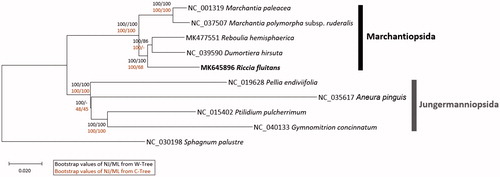Figures & data
Figure 1. Neighbor joining (bootstrap repeat is 10,000) and maximum likelihood (bootstrap repeat is 1,000) phylogenetic tree of ten complete chloroplast genomes: Riccia fluitans (MK645896 in this study), Reboulia hemisphaerica (MK477551), Marchantia polymorpha subsp. ruderalis (NC_037507), Marchantia paleacea (NC_001319), Dumortiera hirsuta (NC_039590), Pellia endiviifolia (NC_019628), Aneura pinguis (NC_035617), Gymnomitrion concinnatum (NC_040133), Ptilidium pulcherrimum (NC_015402), and Sphagnum palustre (NC_030198) as an outgroup. Black bars in the right side indicate specific clades with labels. Phylogenetic tree was drawn based on neighbour joining tree from alignment of complete chloroplast genomes. The numbers above branches indicate bootstrap support values of neighbor joining and maximum likelihood phylogenetic trees from alignment of complete chloroplast genomes (black color) or 63 conserved genes (dart red color), respectively.

